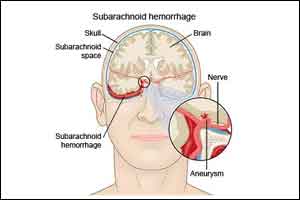- Home
- Editorial
- News
- Practice Guidelines
- Anesthesiology Guidelines
- Cancer Guidelines
- Cardiac Sciences Guidelines
- Critical Care Guidelines
- Dentistry Guidelines
- Dermatology Guidelines
- Diabetes and Endo Guidelines
- Diagnostics Guidelines
- ENT Guidelines
- Featured Practice Guidelines
- Gastroenterology Guidelines
- Geriatrics Guidelines
- Medicine Guidelines
- Nephrology Guidelines
- Neurosciences Guidelines
- Obs and Gynae Guidelines
- Ophthalmology Guidelines
- Orthopaedics Guidelines
- Paediatrics Guidelines
- Psychiatry Guidelines
- Pulmonology Guidelines
- Radiology Guidelines
- Surgery Guidelines
- Urology Guidelines
When is a headache a sign of a deadly brain bleed?

A new tool to identify potentially fatal aneurysms in patients with headaches who seem otherwise well will help emergency departments to identify high-risk patients, improve survival rates and cut out unnecessary imaging, according to new research published in CMAJ (Canadian Medical Association Journal)
A bleeding brain aneurysm referred to medically as a subarachnoid hemorrhage, can cause a sudden headache.
"Although rare, accounting for only 1%-3% of headaches, these brain aneurysms are deadly," says Dr. Jeffrey Perry, an emergency physician with The Ottawa Hospital and the University of Ottawa, Ottawa, Ontario. "Almost half of all patients with this condition die and about 2/5 of survivors have permanent neurological deficits. Patients diagnosed when they are alert and with only a headache have much better outcomes, but can be challenging to diagnose as they often look relatively well."
The Ottawa Subarachnoid Hemorrhage Rule was developed by researchers at The Ottawa Hospital, which also created The Ottawa Rules, decision tools used in emergency departments around the world to identify ankle, knee and spine fractures.
The current study, involving 1153 alert adult patients with acute sudden onset headache admitted to 6 university-affiliated hospitals in Canada over 4 years from January 2010 to 2014, validates earlier published research that initially proposed the Ottawa Subarachnoid Hemorrhage Rule.
"Before any clinical decision rule can be used safely, it must be validated in new patients to ensure that the derived 'rule' did not come to be by chance and that it is truly safe," says Dr. Perry. "This is especially true with a potentially life-threatening condition such as subarachnoid hemorrhage."
The newly validated rule gives emergency physicians a reliable tool to identify high-risk patients and rule out the condition in low-risk patients without having to order time-consuming imaging.
"We hope this tool will be widely adopted in emergency departments to identify patients at high risk of an aneurysm while cutting wait times and avoiding unnecessary testing for low-risk patients," says Dr. Perry. "We estimate that this rule could save 25 lives in Ontario each year."

Disclaimer: This site is primarily intended for healthcare professionals. Any content/information on this website does not replace the advice of medical and/or health professionals and should not be construed as medical/diagnostic advice/endorsement or prescription. Use of this site is subject to our terms of use, privacy policy, advertisement policy. © 2020 Minerva Medical Treatment Pvt Ltd